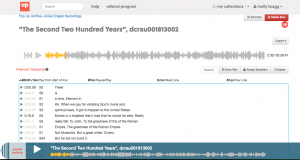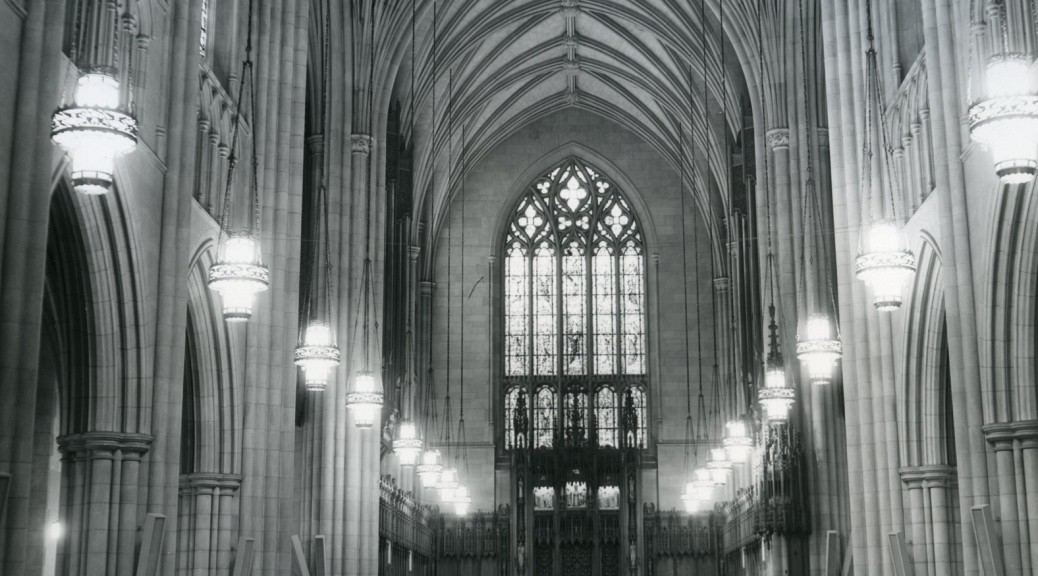Although we launched the Duke Chapel Recordings Digital Collection in April, work on the project has not stopped. This week I finally had time to pull together all our launch notes into a post mortem report, and several of the project contributors shared our experience at the Triangle Research Libraries Network (TRLN) Annual meeting. So today I am going to share some of the biggest lessons learned that fueled our presentation, and provide some information and updates about the continuing project work.

Just to remind you, the Chapel Recordings digital collection features recordings of services and sermons given in the chapel dating back to the mid 1950s. The collection also includes a set of written versions of the sermons that were prepared prior to the service dating back to the mid 1940s.
What is Unique about the Duke Chapel Recordings Project?
All of our digital collections projects are unique, but the Chapel Recordings had some special challenges that raised the level of complexity of the project overall. All of our usual digital collections tasks (digitization, metadata, interface development) were turned up to 11 (in the Spinal Tap sense) for all the reasons listed below.
- More stakeholders: Usually there is one person in the library who champions a digital collection, but in this case we also had stakeholders from both the Chapel and the Divinity School who applied for the grant to get funding to digitize. The ultimate goal for the collection is to use the recordings of sermons as a homiletics teaching tool. As such they continue to create metadata for the sermons, and use it as a resource for their homiletics communities both at Duke and beyond.
- More formats and data: we digitized close to 1000 audio items, around 480 video items and 1300 written sermons. That is a lot of material to digitize! At the end of the project we had created 58 TB of data!! The data was also complex; we had some sermons with just a written version, some with written, audio, and video versions and every possible combination in between. Following digitization we had to match all the recordings and writings together as well as clean up metadata and file identifiers. It was a difficult, time-consuming, and confusing process.
- More vendors: given the scope of digitization for this project we outsourced the work to two vendors. We also decided to contract with a vendor for transcription and closed captioning. Although this allowed our Digital Production Center to keep other projects and digitization pipelines moving, it was still a lot of work to ship batches of material, review files, and keep in touch throughout the process.
- More changes in direction: during the implementation phase of the project we made 2 key decisions which elevated the complexity of our project. First, we decided to launch the new material in the new Digital Repository platform. This meant we basically started from scratch in terms of A/V interfaces, and representing complex metadata. Sean, one of our digital projects developers, talked about that in a past blog post and our TRLN presentation. Second, in Spring of 2015 colleagues in the library started thinking deeply about how we could make historic A/V like the Chapel Recordings more accessible through closed captions and transcriptions. After many conversations both in the library and with our colleagues in the Chapel and Divinity, we decided that the Chapel Recordings would be a good test case for working with closed captioning tools and vendors. The Divinity School graciously diverted funds from their Lilly Endowment grant to make this possible. This work is still in the early phases, and we hope to share more information about the process in an upcoming blog post.

Lessons learned and re-learned
As with any big project that utilizes new methods and technology, the implementation team learned a lot. Below are our key takeaways.
- More formal RFP / MOU: we had invoices, simple agreements, and were in constant communication with the digitization vendors, but we could have used a more detailed MOU defining vendor practices at a more detailed level. Not every project requires this kind of documentation, but a project of this scale with so many batches of materials going back and forth would have benefitted from a more detailed agreement.
- Interns are the best: University Archives was able to redirect intern funding to digital collections, and we would not have finished this project (or the Chronicle) with any sanity left if not for our intern. We have had field experience students, and student workers, but it was much more effective to have someone dedicated to the project throughout the entire digitization and launch process. From now on, we will include interns in any similar grant funded project.
- Review first – digitize 2nd: this is definitely a lesson we re-learned for this project. Prior to digitization, the collection was itemized and processed and we thought we were ready to roll. However there were errors that would have been easier to resolve had we found them prior to digitization. We also could have gotten a head start on normalizing data, and curating the collection had we spent more time with the inventory prior to digitization.
- Modeling and prototypes: For the last few years we have been able to roll out new digital collections through an interface that was well known, and very flexible. However we developed Chapel Recordings in our new interface, and it was a difficult and at times confusing process. Next time around, we plan to be more proactive with our modeling and prototyping the interface before we implement it. This would have saved both the team and our project stakeholders time, and would have made for less surprises at the end of the launch process.
Post Launch work

As I mentioned at the top of this blog post, Chapel Recordings work continues. We are working with Pop Up Archive to transcribe the Chapel Recordings, and there is a small group of people at the Divinity School who are currently in the process of cleaning up transcripts specifically for the sermons themselves. Eventually these transcriptions will be made available in the Chapel Recordings collection as closed captions or time synced transcripts or in some other way. We have until December 2019 to plan and implement these features.
The Divinity School is also creating specialized metadata that will help make the the collection a more effective homiletics teaching tool. They are capturing specific information from the sermons (liturgical season, bible chapter and verse quoted), but also applying subject terms from a controlled list they are creating with the help of their stakeholders and our metadata architect. These terms are incredibly diverse and range from LCSH terms, to very specific theological terms (ex, God’s Love), to current events (ex, Black Lives Matter), to demographic-related terms (ex, LGBTQ) and more. Both the transcription and enhanced metadata work is still in the early phases, and both will be integrated into the collection sometime before December 2019.
The team here at Duke has been both challenged and amazed by working with the Duke Chapel Recordings. Working with the Divinity School and the Chapel has been a fantastic partnership, and we look forward to bringing the transcriptions and metadata into the collection. Stay tuned to find out what we learn next!


